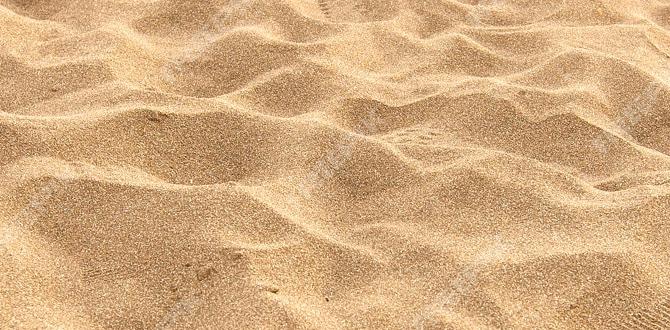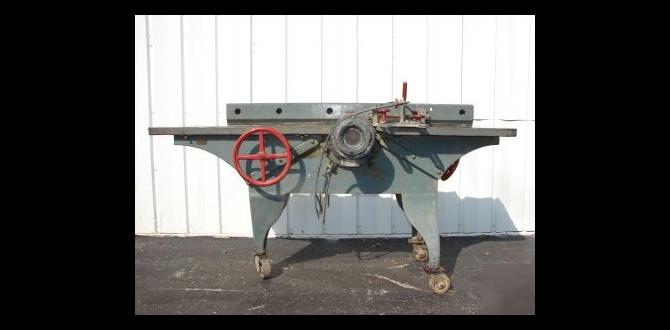Have you ever looked at your old table and thought it could shine again? Many people have. They wonder how to sand table legs properly. Sanding can bring new life to worn-out furniture. It’s a simple yet rewarding DIY task anyone can do.
Imagine walking into a room and seeing a beautiful table that looks brand new. You can create that feeling with just a bit of effort. Sanding can help remove scratches and old paint. Plus, it’s a great way to spend some time being creative.
In this step-by-step DIY guide, we’ll show you exactly how to sand table legs like a pro. You don’t need to be a master craftsman. With clear instructions and the right tools, you’ll feel confident tackling this project.
Are you curious about how easy it can be? Let’s dive in and transform that table together! It’s time to get started on a fun adventure in DIY home improvement.
Table of Contents
How To Sand Table Legs: A Step-By-Step Diy Guide

How to Sand Table Legs: A Step-by-Step DIY Guide
Sanding table legs can feel rewarding and fun! Begin by gathering your supplies: sandpaper, a sanding block, and safety gear. Did you know that a smooth finish makes your furniture look brand new? Start with coarse sandpaper, then switch to finer paper for a polished touch. Pay attention to corners and curves for even results. Finally, wipe away dust before applying your favorite finish. Ready to give your table a makeover? Happy sanding!Choosing the Right Sandpaper
Types of sandpaper: grit options and their uses. Recommendations for different wood types.Picking the right sandpaper is vital for your project. Sandpaper has different types, known as grit. Each grit helps with various tasks:
- Coarse Grit (40-60): Great for heavy sanding and removing old finishes.
- Medium Grit (80-120): Good for smoothing surfaces.
- Fine Grit (150-220): Perfect for finishing and polishing wood.
For different wood types, here’s a recommendation:
- Softwoods: Use medium to fine grit for a smooth finish.
- Hardwoods: Start with coarse grit, then switch to fine grit.
What type of sandpaper should I use for wood?
Always choose sandpaper based on the wood type and desired finish. Use fine sandpaper like 220 grit for softwoods. For hardwoods, start with 120 grit and finish with 220 grit.
Preparing the Work Area
Safety measures and protective gear. Tools and materials needed for sanding.Before you start sanding, make your area safe. Grab some protective gear. Wear safety goggles to shield your eyes. Use ear protection if it gets loud, and wear a mask to filter dust. Gather your tools too. You will need:
- Sander
- Sandpaper
- Work gloves
- Drop cloths
With a clean space and right gear, you are ready to begin!
What safety gear should I wear while sanding?
Always wear safety goggles for eye protection and a mask to avoid inhaling dust.
Cleaning the Table Legs
Removing dust and debris. Checking for previous finishes.Start by removing any dust and debris from the table legs. A clean surface makes sanding much easier. Use a soft cloth or duster to wipe away dirt and cobwebs. Next, check for any old finishes on the legs. If the wood has varnish or paint, you need to remove that first. This step ensures a smooth sanding process.
How do I clean my table legs?
To clean table legs, wipe them down with a cloth to remove dust. Then, check for and remove any old finishes using a scraper or sandpaper.
Starting the Sanding Process
Techniques for sanding with the grain. Tips for using hand sanders vs. power sanders.Before you start sanding, remember to supply the right tools. Always sand with the grain of the wood. This technique helps avoid scratches and leaves a smooth finish. Use hand sanders for small areas. They offer control. For larger surfaces, use a power sander. It makes the job quicker.
- Use a fine grain sandpaper for the final touches.
- Always wear a mask to protect from dust.
- Take breaks to check your work.
What is the best technique for sanding?
The best technique is sanding with the grain. It helps keep your wood clean. Plus, it gives a lovely finish.
Finishing the Sanding
Gradually moving to finer grits. Ensuring an even finish across all legs.To finish sanding your table legs, begin with a coarse grit sandpaper. Then, gradually move to finer grits like 120, 220, and finally 320. This step is important for a smooth surface. Make sure to sand each leg evenly. Use long, even strokes to avoid bumps or scratches. This way, your table will look great!
How do you ensure an even finish on table legs?
Start with coarse sandpaper and move to finer grits. This helps achieve a smooth finish. Sand each leg the same way. Check often to avoid uneven spots. A good finish makes your table beautiful!
Dealing with Nooks and Crannies
Sanding hardtoreach areas. Tools best suited for detailed sanding.Sometimes, table legs have tight spots that are hard to reach. Sanding these nooks and crannies is important for a smooth finish. You can use special tools to help.
- Detail Sanders: These are small and perfect for tiny areas.
- Sanding Sponges: These can bend to fit into corners.
- Foam Blocks: A good choice for rounded edges.
This makes sure every inch looks great!
How do you sand hard-to-reach areas?
Use the right tools! Detail sanders and sanding sponges work well to reach difficult spots easily.
Applying a Finish After Sanding
Types of finishes suitable for table legs. Steps to effectively apply and seal the finish.After sanding, it’s time for the fun part—applying a finish! You can choose from different finishes for table legs, like varnish, stain, or even paint. Each gives a unique look. To apply, first, make sure the legs are clean and dust-free. Grab a brush or a cloth and your favorite finish. Apply a thin layer and let it dry. Don’t rush; nobody likes a sticky mess!
| Finish Type | Appearance | Best For |
|---|---|---|
| Varnish | Glossy and durable | Protection |
| Stain | Rich color | Enhancing wood grain |
| Paint | Bold and vibrant | Creative projects |
For sealing, apply a second coat after the first one dries. This protects your masterpiece from scratches and spills. Remember, it’s like putting on sunscreen—better safe than sorry!
Maintenance Tips for Sanded Table Legs
How to care for your newly sanded legs. Preventing future damage or wear.After you’ve sanded your table legs, a little loving care goes a long way. First, apply a good coat of varnish or oil. This creates a protective layer and makes your legs shine like a new penny! Keep them clean; a damp cloth is your best friend. Avoid placing hot items directly on them; hot stuff likes to cause damage. Finally, keep your table away from moisture. Wood hates being too wet! Follow these tips, and your table legs will remain happy and sturdy for years.
| Tip | Description |
|---|---|
| Use Varnish or Oil | Protects and beautifies the wood. |
| Regular Cleaning | A damp cloth keeps dirt away. |
| Avoid Heat | Hot items can damage the surface. |
| Watch for Moisture | Keep away from water to prevent warping. |
Conclusion
In summary, sanding table legs is easy and rewarding. Start with coarse sandpaper, then move to finer grits for a smooth finish. Remember to sand with the grain and clean up dust afterward. You can transform old furniture into something beautiful. Now, gather your materials and give it a try! For more tips, check out our other DIY guides.FAQs
What Materials And Tools Do I Need To Sand Table Legs Effectively?To sand table legs, you need sandpaper and a sanding block or an electric sander. Start with rough sandpaper, like 80-grit, to remove bumps. Then, switch to smoother sandpaper, like 220-grit, for a nice finish. You might also want a clean cloth to wipe off dust when you’re done.
How Do I Prepare The Table Legs Before Sanding?First, check the table legs for any dirt or dust. Use a clean cloth to wipe them down. If there are any rough spots, you can use a small file or sandpaper to smooth those areas. Make sure to remove any old paint or finish if needed. This will help you get a nice, smooth surface when you sand.
What Sanding Technique Should I Use For Different Types Of Wood?For soft woods like pine, use a coarser sandpaper first, like 80 grit. This helps remove rough spots quickly. For harder woods like oak, start with a finer sandpaper, around 120 grit. Always sand in the direction of the wood grain, so the surface stays smooth. Finish with even finer sandpaper, like 220 grit, for a nice feel.
How Do I Finish The Table Legs After Sanding To Achieve A Smooth Surface?After sanding, you can finish the table legs by applying a coat of wood finish. Start with a clean cloth to wipe off dust. Then, use a brush or a cloth to apply the finish evenly. Let it dry completely before adding a second coat. This will make the surface smooth and shiny!
Are There Any Safety Precautions I Should Take While Sanding Table Legs?Yes, there are important safety precautions to follow when sanding table legs. First, wear a dust mask to protect your lungs from dust. You should also wear safety goggles to keep dust out of your eyes. Make sure to work in a well-ventilated area so you can breathe easier. Finally, keep your fingers away from the sanding area to avoid cuts.




